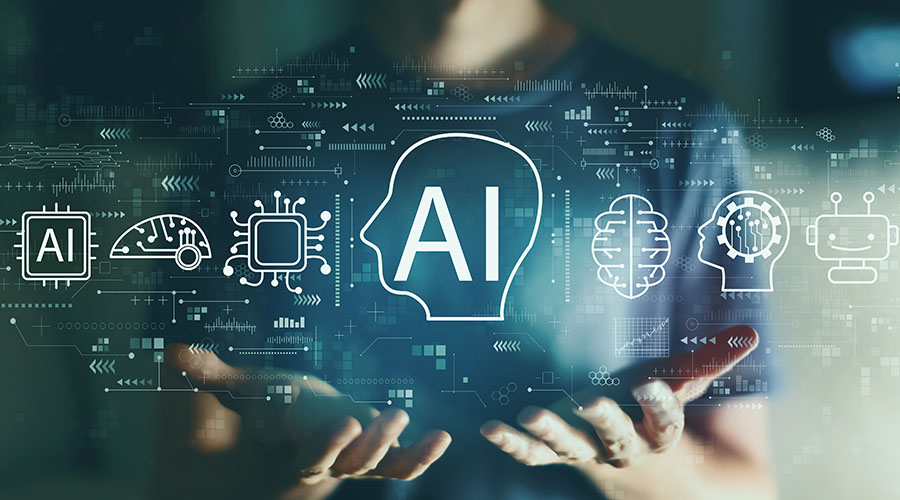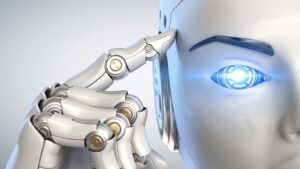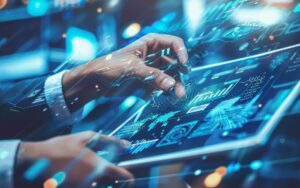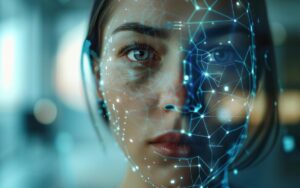Artificial intelligence is one of those concepts that captures the imagination and sometimes, let’s face it, scares people. The idea of computers and machines thinking for themselves is exciting, but it’s an unsettling concept for anyone who’s watched certain science fiction movies or television shows.
But the future of AI technology has more benign potentials, and this article will show it. We will explore the beginnings and evolution of artificial intelligence technologies, recent inventions and innovations, and the pros and cons of artificial intelligence. We will also devote some time focusing on the implications of artificial intelligence and, to a lesser extent, machine learning, in the workplace. Finally, we will show you how you can get in on the future of AI.
Let’s begin our glimpse of the future of artificial intelligence with a backward glance at where it’s been.
The Evolution of Artificial Intelligence
Artificial intelligence involves simulating human intelligence using machines that learn from their experiences and imitate human thinking. AI encompasses a set of technologies that let computers perform various advanced functions, including analyzing data, understanding verbal and written language, and the ability to see, making recommendations, and much more.
The concept of AI has been around for almost a century. However, we can better understand the future of artificial intelligence by tracing its past trajectory. Here’s how artificial intelligence has evolved since those early days.
Also Read: The Double-Edged Sword of AI Deepfakes: Implications and Innovations
The 1950s
British mathematician Alan Turing created the Turing test. If a machine can carry on an indistinguishable human conversation, it is reasonable to consider it a thinking entity.
Also, Claude Shannon, known as the father of information theory, published the article “Programming a Computer for Playing Chess,” which was the first work to develop a chess-playing computer program.
Finally, George Devol invented Unimate, an industrial robot that became the first machine to work on a New Jersey General Motors assembly line. Unimate transported die castings from the assembly line and welded them onto cars, a dangerous job for human workers.
The 1960s
In 1965, computer scientist and professor Joseph Weizenbaum developed ELIZA. ELIZA was an interactive computer program that could hold a functional conversation in English with a person. ELIZA spoke canned lines when specific keywords came up, using programmed scripts.
The 1970s
This decade saw witnessed advancements in robots and automatons. For example, the Wabot Project, which started in 1967, created WABOT -1, considered the first anthropomorphic robot. It was built in Japan at Waseda University, and its features included moveable limbs and the ability to see and speak. It could also measure object distances and directions using external receptors, artificial ears, and eyes.
The 1980s
Corporations worldwide adopted an AI program called Expert Systems, which was adopted by corporations worldwide and became the focus of mainstream AI research. Waseda University built WABOT -2, which could communicate with people and read musical scores, playing music on an electronic organ.
The 1990s
In this decade, a new paradigm called Intelligent Agents became widely accepted. This paradigm perceives its environment and acts to maximize its chances of success. For example, computer scientist Richard Wallace, inspired by Weizenbaum’s ELIZA, developed the A.L.I.C.E (Artificial Linguistic Internet Computer Entity) chatbot. A.L.I.C.E. was different from ELIZA because of the addition of a sample data collection of natural language.
And AI machines weren’t just talking; they were playing chess. Deep Blue, the chess-playing computer developed by IBM in 1997, became the first to win against a reigning world champion.
Incidentally, according to the Terminator movies, Skynet, the artificial intelligence system designed to run America’s defense systems, became self-aware in 1997. Looks like we dodged a bullet there!
The 2000s
The 21st century brought access to more data, considerably faster computers, and advanced machine-learning techniques. Professor Cynthia Breazeal developed Kismet in 2000. Kismet could recognize and imitate emotions with its face, structured like a human face, complete with eyes, lips, eyelids, and even eyebrows.
Meanwhile, Google secretly developed a driverless car in 2009.
The 2010s
Google’s driverless car passed Nevada’s self-driving test in 2014. And by 2016, the AI-related hardware and software market exceeded $8 billion. Additionally, worldwide spending on artificial intelligence systems is estimated to hit $35.8 billion in 2019 and more than double to $79.2 billion in 2022.
It’s already been an exciting road, and it will be intriguing to see how artificial intelligence and the future of humans play out in the next few decades.
Also Read: Performance Modeling: What is an ROC Curve?
Recent AI Inventions and Innovations
Artificial intelligence-based innovations and inventions have exploded over the past few decades, and as future AI technology improves, that rate will keep growing faster. Here’s a quick sampling of more exciting and successful artificial intelligence developments.
- 2010. ImageNet launched its annual artificial intelligence object recognition competition called the ImageNet Large Scale Visual Recognition Challenge (ILSVRC). Meanwhile, Microsoft debuted the Kinect for Xbox 360. Kinect was the first gaming device that could track human body movement through a 3D camera and infrared detection.
- 2011. Apple released its iOS operating system virtual assistant Siri, which uses a natural-language user interface to observe, answer, infer, and make recommendations things to its user. Siri distinguished itself by adapting voice commands and projecting an individualized user experience.
- 2012. Cats, videos, and artificial intelligence all came together in one glorious moment when two Google researchers trained an extensive 16,000-processor neural network to recognize cat images by showing the network 10 million unlabeled images from YouTube videos.
- 2014. Microsoft threw its hat into the virtual assistant ring by releasing Cortana. Not to be outdone or left out, Amazon created Amazon Alexa, a home assistant based on smart speakers that work as personal assistants.
- 2015. Google’s DeepMind developed AlphaGo, a computer program that plays the board game Go, and it defeated various human champions.
- 2016. Hanson Robotics created Sophia, a humanoid robot called the first Robot citizen. Thanks to her ability to see with image recognition, communicate through AI, and make facial expressions, Sophia has raised the bar on human-like robots.
Examples of AI in the Workplace
Artificial intelligence has also made many inroads in today’s workplace. As we consider the future of AI technology, what it will look like, and how it will be applied, here are a few examples of AI in today’s workplace.
- Resume screening
- Voice assistants on your phone (Alexa, Google Assistant, and Siri)
- Customer service call centers
- The Google search engine
- Anti-collision technology in a company vehicle
- Machinery maintenance analysis and scheduling
- Tumor location and illness diagnosis
Also Read: Exploring the Artificial Intelligence Career Path
The Pros of AI in the Workplace
The future of AI will rely in part on how well people grasp the benefits of artificial intelligence and apply them to today’s workforce, everything from the boardroom to the factory floor. Here’s a partial list of the benefits of AI in today’s workplace.
- It perfectly performs dull, repetitive jobs. Artificial intelligence efficiently automates menial chores and eliminates boring tasks for employees so that they can focus on the more rewarding, creative aspects of their careers.
- It makes unbiased decisions. AI has no emotions to influence its decisions, thereby eliminating bias.
- It aids in the invention process. AI-based technologies make it easier to help researchers develop technologies that overcome current issues.
- It reduces human error. AI ‘s precision and accuracy significantly reduce mistakes to practically zero, contingent on programmers entering the proper initial algorithms and information.
- It handles dangerous jobs. Whether in the cold of space, the heat of a volcano, or the crushing pressure of the ocean floor, AI-powered robots can perform critical tasks in environments otherwise harmful to humans.
- It never sleeps, calls in sick, or needs a personal day. AI is available 24×7 and works faster than its flesh and blood counterparts.
- It can handle user demands without getting burned out or annoyed. Let’s face it; sometimes, customers can be jerks, taking a toll on customer service reps. AI-powered digital assistants, chatbots, and voice bots can handle people’s requests, no matter how rude the requester is.
- It creates more jobs. Although we’ll see the reverse of this in the disadvantages section, AI creates the demand for more machine managers, data detectives, robotics engineers, and programmers.
The Cons of AI in the Workplace
Of course, it’s not all hearts and flowers for artificial intelligence. Like other innovations, AI has its downside. Here’s a glance at AI’s disadvantages.
- It is costly. It costs much to mimic human intelligence, including time, resources, and money.
- It causes unemployment. If an AI robot is working on an assembly line, that’s one less human worker doing the job. Now multiply this by thousands, even millions. People losing their jobs to high technology remains one of the greatest job-related fears.
- It can cause overdependency. In the Pixar movie Wall-E, future humans lie like slugs on their couches and let machines do all the work. Although that’s clearly taking the idea to ludicrous extremes, it has its roots in a genuine concern: people will come to excessively rely on AI, letting their mental faculties atrophy.
- It’s not creative. Although artificial intelligence does an excellent job of mimicking human analytical thinking and reasoning, it needs to improve in the act of creation. Currently, AI lacks significant imagination, although perhaps that’s for the best (from the perspective of writers and artists in general!).
- It lacks ethics and emotion. Artificial intelligence lacks empathy, emotion, and ethics. It can’t form teams or communities, encourage cooperation, or consider simple human decency.
- All that computing power is bad for the environment. Increasingly complex computers require increasing amounts of power, which means more power plants generating that energy and spewing pollutants into the environment.
Also Read: What Is a Generative Adversarial Network? Types, How They Work, Pros, and Cons
Five Things to Expect from AI in the Next 10 Years
In the next decade, we will see how the future of AI helps us to work and live. Here are five solid examples of what to expect.
- Business administration. If business management primarily involves noticing and properly assigning talent, AI might soon be able to fill that role better.
- Health care. Imagine combining a doctor’s experience and human intuition with the precision of artificial intelligence! The amount of information we’ve generated about the human body has far outstripped the capacity of any single brain to remember, process, and act upon. So, AI could fill the gap.
- Financial transactions. Advanced artificial intelligence face recognition algorithms will soon be fast and inexpensive enough to support millions of daily transactions, although there’s much more potential. Machine learning can teach computers to recognize users through increased biometric factors such as voice recognition.
- Investments. Just like cloud computing allows small businesses to compete with big corporations, AI-powered financial and investment advice could give us “regular” folk a chance to become more financially secure like the rich are and do it inexpensively.
- Linguistics. Real-time machine translation already exists (e.g., Skype and Microsoft), but other researchers from organizations like Google and DARPA want to push the envelope.
- Shopping. Artificial intelligence has already revolutionized shopping, but it’s just getting started. Online shopping algorithms are already commonplace, but things could be taken to the next level with AI not only suggesting the perfect product to users but confirm that the item is in stock and, if not, initiating a restock through the supply chain.
- Sports. Modern machine learning algorithms can help devise the perfect offensive formation or correct bad habits in individual athletic performances, provided the data is available and collected.
What Industries Will Artificial Intelligence Change?
The future of artificial intelligence is the future of today’s commercial landscape. Here are but a few examples of how artificial intelligence, and certifed AI professionals, will change specific industries.
- Cybersecurity. Cybersecurity is a big deal, and AI is already being developed to detect online fraud and protect consumers intelligently. For example, AI can see spending habits and credit activity changes, sending flags indicating potential credit card theft.
- Health care. Doctors can better diagnose illnesses and maybe use AI to create new ways to combat dementia and cancer. Doctors could also use AI to predict future diseases by factoring a patient’s health history with genetic data and devising a preventative care plan.
- Law enforcement. AI-based facial recognition in security cameras can help police officers track down potential criminals. AI-run robots are already employed as security officers in certain businesses.
- Marketing. AI is already targeting us with customized ads on social media sites, but eventually, AI-powered programs may even be able to create complete ads or articles. A few articles and ad-writing bots already exist, and their developers claim they’re almost as good as human writers (spoiler alert: they’re not yet).
- Service industry. AI-powered robots and machines could replace customer service representatives, cashiers, and even cooks. For example, robots are operating french-fry baskets at some fast-food restaurants.
- Transportation. We’re already witnessing the self-driving vehicle phenomenon. As technology gets better, we’ll see it more often.
Also Read: What Is Transfer Learning in Machine Learning?
Do You Want to Be a Part of the Future of AI?
The fields of both artificial intelligence and machine learning are expected to greatly impact our future, so if you want to become a part of this exciting, innovative revolution, you can begin by mastering the technology through this highly effective artificial intelligence course. This highly effective and informative AI and ML bootcamp will help you master AI in just a short six months. You will get a high-engagement learning experience and more than 25 hands-on projects to teach you critical, timely skills like:
- Computer Vision
- Deep Learning
- Ensemble Learning
- GANs
- Neural Networks
- NLP
- Reinforcement Learning
- Speech Recognition
Ziprecruiter.com reports that artificial intelligence engineers working in the United States earn an average annual salary of $156,648.
So, take that critical first step into the future and a better career by signing up for a cutting-edge AI Bootcamp.
You might also like to read:
What is Reinforcement Learning in AI?
What is Sustainable AI? Definition, Significance, and Examples
The Top 10 Natural Language Processing Applications
Explainable AI: Bridging the Gap Between Human Cognition and AI Models
AI in Human Resources: Improving Hiring Processes with Predictive Analytics







1 thought on “The Future of AI: What You Need to Know in 2025”
Pingback: What is Machine Learning? A Comprehensive Guide for Beginners - Caltech